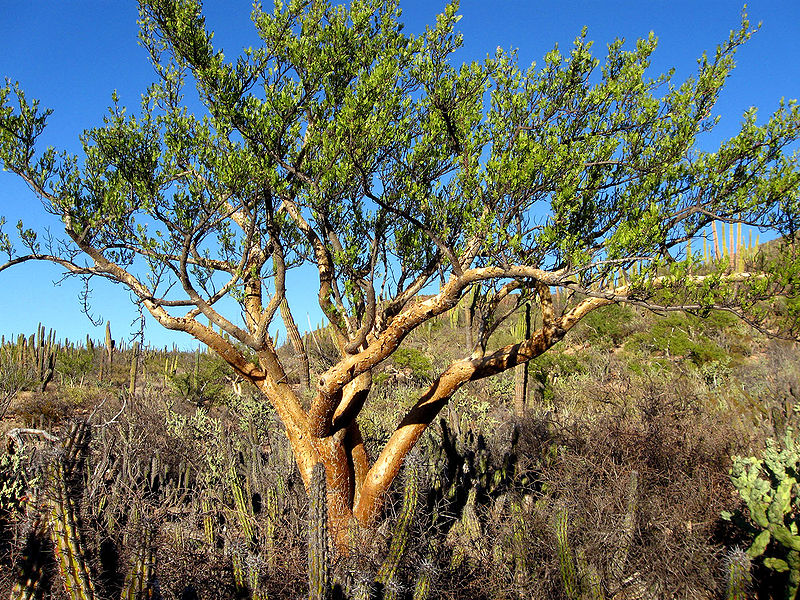

Contributor
- Topics: Archive

When is a eucalypt not a Eucalyptus? When it’s an Angophora-at least according to most people. This eastern Australian genus of up to fifteen species of trees and large shrubs was first published as a separate group in 1797 (just nine years after Eucalyptus), because its members have flowers with small sepals and petals but lacking the distinctive operculum (bud cap) of other eucalypts. Another distinction is that angophoras usually have opposite, not alternate, leaves. Although the genus Angophora is still accepted by most botanists as being separate from Eucalyptus, eucalypt taxonomy in general has been the subject of much debate in recent times (see box to right).
Known as “apples” in their native Australia (because of the resemblance of some species to apple trees), there are several species of Angophora that make attractive landscape plants. Of these, the most noteworthy is smooth-barked apple (Angophora costata). Also known as Sydney red gum, this majestic tree is native from Southern Queensland to Sydney in New South Wales and is particularly famous for the nearly pure stands of it, which form enchanted forests on sandstone soils in the Sydney region. It is said that the blood red, gummy sap of this tree inspired pioneer botanist Sir Joseph Banks to first coin the name “gum tree,” a term that eventually would become synonymous with Australia itself.

In its natural habitat, Angophora costata is a large, wide spreading tree that grows to a height of forty to one hundred feet tall. Its distinctive and handsome trunk is often gnarled and crooked, with a pink to pale gray, sometimes rusty-stained bark. Although, at first glance, it might look like just another Eucalyptus, it is easily distinguished by the fact that its four- to six-inch-long, dark green to gray green, lance-shaped leaves are arranged opposite each other along its branchlets. New flushes of growth can be quite showy, with young leaves a deep wine red color. Angophora costata is also showy in flower, its inch-wide, fluffy white flowers with many stamens produced in large terminal clusters. The seed capsules that follow are one-half-inch long and wide, with a shape and prominent ribs that gave the tree its botanical name (Angophora is from two Greek words meaning “goblet” and “bearing” and costata is the Latin word for “ribbed”).

In cultivation in California, Angophora costata grows quickly to thirty to fifty feet tall, and tolerates a wide variety of soils including poor or rocky soils. It grows upright at first and becomes spreading with age, and is completely drought tolerant. The nectar-rich flowers of this species make it valuable (with the help of bees) as a honey-producing tree, and both the foliage and bark have been used as dye materials. Although young plants may suffer minor frost damage, mature trees are hardy to brief periods of cold temperatures as low as 20∞ F. This is a tree that can tolerate coastal exposure but also grows well in inland areas where frosts are not severe. Because it can have brittle wood, it is not a good choice for planting near structures or parking lots-to develop the best specimen, over-watering should be avoided to encourage slower growth and a stronger branching structure. Propagation is easy by seed, and, like all eucalypts, trees should be planted only when young and not root-bound.
The Name Game
There is no denying that the over 700 species of plants collectively called eucalypts include Australia’s grandest and most well-known trees. But are all eucalypts in the genus Eucalyptus? This is a large and diverse group, with many species having diverged considerably from supposed common ancestors.
In recent times, as botanists have attempted to more precisely classify the affinities within the eucalypts, there has been some taxonomic shifting proposed between genus and subgenus levels, with three basic schemes still vying for acceptance. The most conservative scheme places all eucalypts within the genus Eucalyptus, although it recognizes various subgroups (such as Eudesmia, Symphyomyrtus and Monocalyptus) as subgenera. The most traditional scheme, dating back to the eighteenth century, recognizes two genera: Angophora, including thirteen species and subspecies, with the rest being classified as Eucalyptus.Finally, a third scheme, which is gaining widespread acceptance, recognizes Angophora and Corymbia (making the familiar lemon-scented gum Corymbia citriodora and the red-flowering gum Corymbia ficifolia, for example), with all other eucalypts remaining in Eucalyptus.
There are many good reasons for all of these proposed classifications, and much intelligent thought and research is the basis for each of them. Acceptance of botanical name changes takes time, however, and, if you get just the right botanists together, you are still likely to witness a heated argument on the subject! For some of us, this just makes the eucalypts all the more interesting.
Share:
Social Media
Garden Futurist Podcast
Most Popular
Videos
Topics
Related Posts

Ground Up Science for Greener Cities with Garden Futurist Dr. Alessandro Ossola
Spring 2023 Listen to the Podcast here. Alessandro Ossola is a scientist who gets very excited about the challenge of climate change allowing for an

Readying Urban Forests for Climate Realities with Garden Futurist Dr. Greg McPherson
Winter 2023 Listen to the Podcast here. “Going from the mow and blow to a more horticulturally knowledgeable approach to maintaining the landscape. And that

Welcome, Greywater, to the Garden
Summer 2022 Oh, summer: delightful warm air, tomatoes swelling on the vine, fragrant blooms on an evening stroll. When it’s warm and rainless, how is

Big Tree-Data and Big-Tree Data with Garden Futurist Matt Ritter
Summer 2022 Listen to the full Garden Futurist: Episode XV podcast here. We are in an environmental crisis right now in many parts of California









Responses